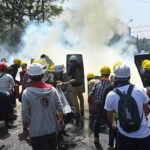SAN FRANCISCO — Thanks in large part to climate change, the world’s future will be marked by a dramatic increase in wildfires, according to a new report by the United Nations Environment Program.
The report cites two primary factors — climate change and land-use change — as driving an increase in extreme wildfires, and it projects that their number will rise by 14 percent by 2030, by 30 percent by the end of 2050 and by 50 percent by 2100.
“Wildfires are burning longer and hotter in places they have always occurred, and are flaring up in unexpected places too, in drying peatlands and on thawing permafrost,” the report states.
Greenhouse gases that have been added to the Earth’s atmosphere, as a result of humans burning fossil fuels, are the driver of rising global temperatures. Since the dawn of the Industrial Revolution, global surface temperatures have risen by roughly 1.8 degrees Fahrenheit, according to the National Oceanic and Atmospheric Administration.
Climate change also results in more extreme weather events, the U.N. report states, including stronger winds, more dry lightning and higher overall temperatures that dry out more quickly the vegetation that fuels wildfires. All those consequences have risen in tandem over recent decades as the pace of climate change accelerates. “The heating of the planet is turning landscapes into tinderboxes, while more extreme weather means stronger, hotter, drier winds to fan the flames,” the report states.
At the same time, humans continue to build homes and other structures in areas already prone to wildfires. Scientists have long warned that the mixture of a changing climate and the addition of new dwellings in wildfire-prone areas is extremely dangerous, and the new U.N. report confirms that conclusion.
The Camp Fire of 2018, the deadliest and most destructive wildfire in California history, was just such an example.
Climate change has also expanded the frequency of wildfires as well as the areas where they occur.
“Over the last decade, it appears that more wildfires are occurring, not only in regions where seasonal fires are common, but also in areas where fires do not normally occur,” the report states. “For example, eastern Australia and the west coast of the United States of America generally experience frequent summer fires, but the 2019–2020 fire season saw record-breaking numbers and extent of wildfires in these regions. The Arctic and the Amazon, however — areas not generally prone to extensive wildfires — experienced record-breaking blazes in recent years.”
For every degree Celsius of warming, for instance, the moisture held in the Earth’s atmosphere rises by 7 percent. But rainfall patterns have also been disrupted by global warming, resulting in severe drought like the one currently gripping the Western portion of the United States. According to figures from the World Economic Forum, summer wildfire seasons in the Western U.S. “are already 40 to 80 days longer on average than they were 30 years ago.”
In California, 17 of the state’s 20 largest wildfires on record have occurred in the past two decades, figures complied by the California Department of Forestry and Fire Protection show. While this year’s rainy season got off to a promising start in California, with some new records for precipitation set in northern parts of the state, January was one of California’s driest months in recorded history, a pattern that has residents and climate scientists on edge.
October and December were extremely wet in parts of California (record wet in some parts of NorCal). But the most recent ~45 day stretch (Jan 1-Feb 17) has been among driest mid-winter periods on record most of CA, NV, UT, and portions of adjacent states. #CAwx #CAwater (1/3) pic.twitter.com/qS3rrQJmUV
— Daniel Swain (@Weather_West) February 17, 2022
The costs associated with wildfires have also been on the rise, the U.N. report finds.
“Annual firefighting expenditure by USA federal agencies has increased to US$1.9 billion (a rise of more than 170 per cent in a decade; National Interagency Fire Center 2021),” the report states. “In Canada, total annual expenditure for national wildland fire management activities ranges between CAD 500 million and CAD 1 billion, an increase of about CAD 120 million per decade since the 1970s.”
Of course, where there are wildfires, there’s also smoke, and “respiratory effects are the most frequently and consistently observed impacts” on human health, the report states, adding, “Studies indicate that wildfire smoke is significantly associated with risk of respiratory morbidity. Respiratory morbidities are more frequently observed in people middle-aged and older.”
The report, the most comprehensive of its kind, urges policymakers to address a range of solutions, including better forest management and the lowering of greenhouse gas emissions into the atmosphere, to address the growing risks that wildfires pose to the planet.
“To better prepare ourselves and limit the widespread damage done by wildfires, we need to take heed of the clear warnings and recommendations for future action outlined in this report,” the authors write. “We must work with nature, communities, harness local knowledge, and invest money and political capital in reducing the likelihood of wildfires starting in the first place and the risk of damage and loss that comes when they do.”




